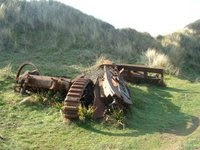US Army WWII Assault Training Centre (ATC)
I currently live in North Devon "Braunton" which happens to be right on the doorstep of a very extensive US Army WWII training area. Ever since moving to the area I was aware of local clues such as people refering to a road on Braunton Burrows as "The American Road". Braunton Burrows is a large area of grassed sand dunes that to the untrained eye appears to be nothing more than a Nature Reserve. Last summer while reading the Local Paper I learnt of a guided tour by a gentleman by the name of Richard Bass. Richard along with others has carried out extensive research into the ATC located in North Devon and has written several books, so what a spot of luck.
The ATC stretched from Crow Point on Braunton Burrows to just beyond Woolacombe. It was a massive training area designed to replicate the beaches of Normandy and helped to train some 10,000 US servicemen that took part in the Operation Overlord - D Day. Very little remains obviously visible today apart from several concrete mock up Landing Craft and bunkers but the more you search the more you may find. (Be aware that this still is a military training area and could possibly contain dangerous unexploaded ordnance, no digging or metal detecting is allowed)
There are unconfirmed rumours that when the US Army pulled out they buried a large amount of equipment however nothing has been found to date, again see the warning above regarding explosive ordnance. The mystery of hidden artifacts is probably wishful thinking maybe, you would probably find old bikes and the like stolen from the local community used to get back to the Burrows after a night out in the village.



The picture on the left shows the Tanks left hand drive gear including the track. The picture on the right shows an aerial view of all the debris. A stroke of luck however was that about a week later whilst in London I happened to visit the Imperial War Museum and to my surprise they have a complete Matilda Tank so I took a picture for comparison, sorry about being in the picture but my good lady insists that every picture she takes should have someone in it. I wonder where the turret from the wreck went? Cobbaton Combat Collection?